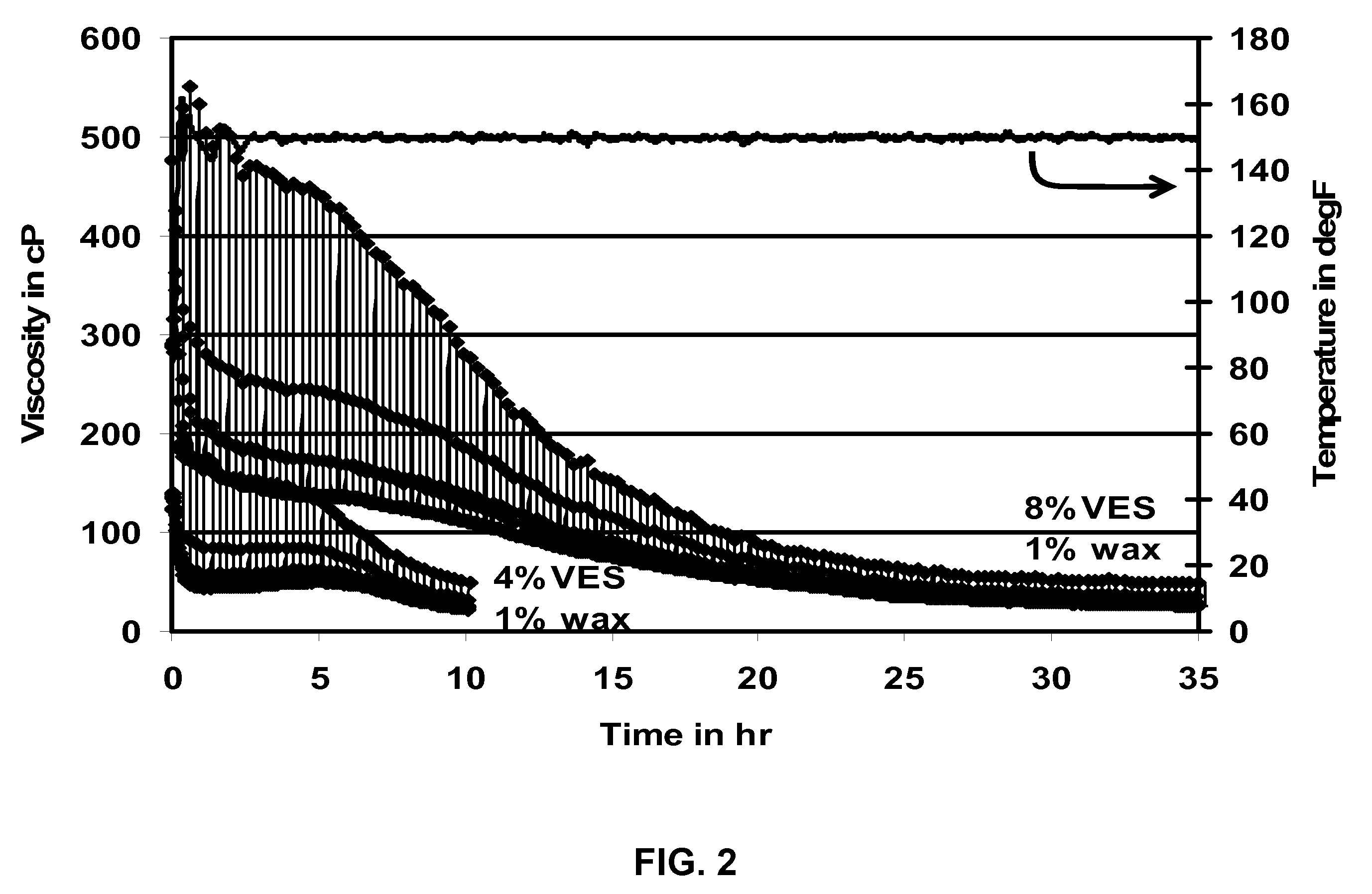Internal breaker for oilfield treatments
a technology of oilfield treatment and internal breakers, which is applied in the direction of fluid removal, chemistry apparatus and processes, borehole/well accessories, etc., can solve the problems of unsatisfactory fluid loss, undesirable rate of fluid leakage into porous rock, and inability to maintain the filter cak
- Summary
- Abstract
- Description
- Claims
- Application Information
AI Technical Summary
Benefits of technology
Problems solved by technology
Method used
Image
Examples
example 1
Waxes
[0113]As with other materials suitable as IFCMB's, when wax particles are significantly smaller that the formation pore sizes, then the wax particles act only as sources of a breaker. In this case, they release a breaker for most viscoelastic surfactant based fluid systems when they melt. When the particles are larger relative to the pore throats of the formation, they form an internal filter cake, and then when they melt they provide the breaker. One skilled in the art will know how to choose the appropriate size range that will or will not form an external or internal filter cake for a given formation, and will know how to test to determine the proper wax particle concentration.
[0114]FIG. 1 shows the viscosity as a function of time at 65.6° C. (150° F.) of a fluid viscosified with 4 weight percent of a viscoelastic surfactant concentrate containing about 38 weight % erucylamidopropyl dimethyl betaine surfactant, 1.1 weight % polynaphthalene sulfonate, 22 weight % isopropanol,...
example 2
Polyesters
[0120]That carboxylic acids released by the degradation of polyesters are VES breakers is demonstrated in FIG. 7, which shows measurements of the viscosity of one example of a VES fluid system with different amounts of glycolic acid (GA) dissolved in the fluid. Measurements were conducted at 66° C. (150° F.). The buffer used in the experiments shown in FIG. 7 was sodium sesquicarbonate, which was used at a concentration of 30 pounds per thousand gallons (3.6 g / L) in all experiments. The VES fluid system was made with 6% of the same viscoelastic surfactant concentrate as was used in Example 1. This experiment showed the results that would be seen as polyglycolic acid (PGA) degrades, and demonstrates the breaking effect on the fluid viscosity as the PGA hydrolyzes to form glycolic acid. In addition, the data in the figure also demonstrate that the viscosity of this VES is not significantly reduced by the addition of a pH buffer to maintain the fluid pH at approximately 9.5.
[...
example 3
Dry Emulsions
[0123]The dry emulsion used was obtained from Rhodia, Inc. Cranbury, N.J., U.S. A. and was made by preparing a dispersion of an oil phase in water using a hydrophilic polymer as the shell-polymer, and then drying the resulting emulsion to form a dry solid. Such dry emulsions are usually stabilized with a surfactant and / or with a hydrophilic polymeric stabilizer. Such dry emulsion materials are a very convenient method of encapsulating organic compounds that are VES breakers, by dissolving them in the oil phase before formation of the dry emulsion. The choice of oil solvent type and amount, surfactant type and concentration, hydrophilic polymer type and amount, and VES breaker type and concentration in the oil, all have an impact on the particle size of the “dried emulsion”, as well as on the extent of the break, and the delay, when the IFCMB is used to break a VES fluid system. All of these selections depend upon the required conditions for the specific oilfield applica...
PUM
| Property | Measurement | Unit |
|---|---|---|
| size | aaaaa | aaaaa |
| size | aaaaa | aaaaa |
| temperature | aaaaa | aaaaa |
Abstract
Description
Claims
Application Information
 Login to View More
Login to View More - R&D
- Intellectual Property
- Life Sciences
- Materials
- Tech Scout
- Unparalleled Data Quality
- Higher Quality Content
- 60% Fewer Hallucinations
Browse by: Latest US Patents, China's latest patents, Technical Efficacy Thesaurus, Application Domain, Technology Topic, Popular Technical Reports.
© 2025 PatSnap. All rights reserved.Legal|Privacy policy|Modern Slavery Act Transparency Statement|Sitemap|About US| Contact US: help@patsnap.com



